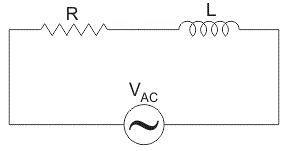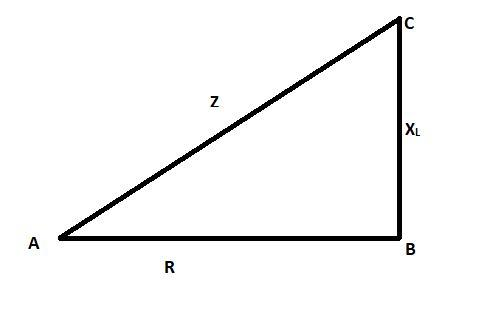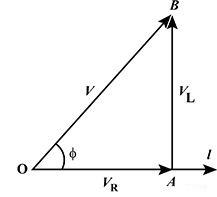
Deduce expression for the resultant potential difference, impedance and current in L-R alternating circuit. Draw a graph to show the phase difference between the current and voltage.
Answer
576.3k+ views
Hint: In L-R circuit an inductor and a resistance are connected in series with a voltage source. Due to current in the circuit there is potential drop across the resistor and the inductor.
Complete step by step solution:
A pure resistance $R$ and a pure inductive coil of inductance $L$ as shown connected in series along an alternating current source.

Let $V=$r.m.s. value of the applied voltage,
$I=$r.m.s value of the resultant current in the circuit.
${{V}_{R}}=IR$ is the voltage drop across the resistor which is in phase with the current $I$,
${{V}_{L}}=I{{X}_{L}}$ is the voltage drop across the inductor which is ahead of $I$ by $90{}^\circ $.
The applied voltage from the alternating voltage source is the vector sum of the voltage drop across the resistor and the inductor.
\[\begin{align}
& V=\sqrt{V_{R}^{2}+V_{L}^{2}} \\
& =\sqrt{{{\left( IR \right)}^{2}}+{{\left( I{{X}_{L}} \right)}^{2}}} \\
& =I\sqrt{{{R}^{2}}+X_{L}^{2}}
\end{align}\]
The quantity \[\sqrt{{{R}^{2}}+X_{L}^{2}}\] is known as the impedance of the circuit. Impedance of the circuit is represented as $Z$.
As seen from the impedance triangle ABC,

$\begin{align}
& {{Z}^{2}}={{R}^{2}}+X_{L}^{2} \\
& {{\left( \text{Impedance} \right)}^{2}}={{\left( \text{Resistance} \right)}^{2}}+{{\left( \text{Inductive Reactance} \right)}^{2}} \\
\end{align}$
From the given figure it is clear that the applied voltage V leads the current I by an angle ϕ such that

$\tan \phi =\dfrac{{{V}_{L}}}{{{V}_{R}}}=\dfrac{I{{X}_{L}}}{IR}=\dfrac{{{X}_{L}}}{R}=\dfrac{\omega L}{R}$
$\therefore \phi ={{\tan }^{-1}}\left( \dfrac{\omega L}{R} \right)$
Note: - Across inductor voltage leads the electric current.
- Across the resistor the voltage is in phase with electric current.
Complete step by step solution:
A pure resistance $R$ and a pure inductive coil of inductance $L$ as shown connected in series along an alternating current source.

Let $V=$r.m.s. value of the applied voltage,
$I=$r.m.s value of the resultant current in the circuit.
${{V}_{R}}=IR$ is the voltage drop across the resistor which is in phase with the current $I$,
${{V}_{L}}=I{{X}_{L}}$ is the voltage drop across the inductor which is ahead of $I$ by $90{}^\circ $.
The applied voltage from the alternating voltage source is the vector sum of the voltage drop across the resistor and the inductor.
\[\begin{align}
& V=\sqrt{V_{R}^{2}+V_{L}^{2}} \\
& =\sqrt{{{\left( IR \right)}^{2}}+{{\left( I{{X}_{L}} \right)}^{2}}} \\
& =I\sqrt{{{R}^{2}}+X_{L}^{2}}
\end{align}\]
The quantity \[\sqrt{{{R}^{2}}+X_{L}^{2}}\] is known as the impedance of the circuit. Impedance of the circuit is represented as $Z$.
As seen from the impedance triangle ABC,

$\begin{align}
& {{Z}^{2}}={{R}^{2}}+X_{L}^{2} \\
& {{\left( \text{Impedance} \right)}^{2}}={{\left( \text{Resistance} \right)}^{2}}+{{\left( \text{Inductive Reactance} \right)}^{2}} \\
\end{align}$
From the given figure it is clear that the applied voltage V leads the current I by an angle ϕ such that

$\tan \phi =\dfrac{{{V}_{L}}}{{{V}_{R}}}=\dfrac{I{{X}_{L}}}{IR}=\dfrac{{{X}_{L}}}{R}=\dfrac{\omega L}{R}$
$\therefore \phi ={{\tan }^{-1}}\left( \dfrac{\omega L}{R} \right)$
Note: - Across inductor voltage leads the electric current.
- Across the resistor the voltage is in phase with electric current.
Recently Updated Pages
Master Class 12 Business Studies: Engaging Questions & Answers for Success

Master Class 12 Social Science: Engaging Questions & Answers for Success

Master Class 12 English: Engaging Questions & Answers for Success

Master Class 12 Chemistry: Engaging Questions & Answers for Success

Class 12 Question and Answer - Your Ultimate Solutions Guide

Master Class 12 Economics: Engaging Questions & Answers for Success

Trending doubts
How much time does it take to bleed after eating p class 12 biology CBSE

When was the first election held in India a 194748 class 12 sst CBSE

December 10th of 1948 is an important day in the history class 12 sst CBSE

The computer jargonwwww stands for Aworld wide web class 12 physics CBSE

The first microscope was invented by A Leeuwenhoek class 12 biology CBSE

Give simple chemical tests to distinguish between the class 12 chemistry CBSE




